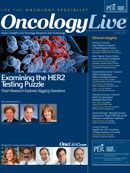Publication
Article
Oncology Live®
Examining Crizotinib's Potential Uses
Author(s):
The development of crizotinib has helped crystallize a relatively rare molecular subset of NSCLC and holds the potential for wider use in treating patients with the disease.
Sai-Hong Ignatius Ou, MD, PhD
The development of crizotinib (Xalkori) has helped “crystallize” a relatively rare molecular subset of nonsmall cell lung cancer (NSCLC) and holds the potential for wider use in treating patients with the disease, according to one of the original investigators.
Sai-Hong Ignatius Ou, MD, PhD, presented an overview of crizotinib recently in the Expert Review of Anticancer Therapy. He is an associate clinical professor and a hematologic oncologist in the Department of Medicine, Division of Hematology Oncology, Chao Family Comprehensive Cancer Center, University of California Irvine Medical Center in Orange, California.
Crizotinib is indicated for the treatment of a highly specific population of patients with advanced NSCLC with an anaplastic lymphoma kinase (ALK) mutation. It is estimated that only about 5% of NSCLC cases worldwide have an ALK gene mutation.
Enhancing its impact as a targeted therapy, crizotinib was approved with a companion, first-of-a-kind genetic test called the Vysis ALK Break Apart FISH Probe Kit. The test further personalizes crizotinib treatment by ensuring that the patients who receive the drug are those whore are most likely to benefit from treatment.
The FDA approved crizotinib based on response rate, not survival data, in two single-arm trials. Investigators gave 500 mg/day of crizotinib to 255 patients with late-stage ALK-rearranged NSCLC. The median age of the patients was 52 years. In the two studies, 96% and 98% had adenocarcinoma, and 93% and 96% had metastatic disease. Nearly all participants had received prior systemic treatment for NSCLC.
The primary endpoint of both trials was overall response rate (ORR). The ORR was 50% (95% confidence interval [CI], 42%-59%) in the first trial and 61% (95% CI, 52%-70%) in the second. The median duration of response was 41.9 weeks and 48.1 weeks, respectively.
The most common adverse events were vision problems, nausea, diarrhea, vomiting, edema, and constipation. The FDA issued warnings and precautions for pneumonitis, liver enzyme abnormalities, and QT interval prolongation.
The road to market was quick for crizotinib, Ou noted. It took only four years from the discovery of ALK-rearranged NSCLC for Pfizer Inc to obtain conditional approval for the drug in August 2011. Ou said that before crizotinib, the discovery of ALK and ALK-rearranged NSCLC was just information of “scientific interest.”
Clinical trials to demonstrate improvements in outcomes or survival in patients receiving crizotinib are ongoing. “The next five years will tell us whether upfront treatment with crizotinib will be the standard of care for ALK-rearranged NSCLC patients, as results from the first-line crizotinib randomized trial will be available,” Ou said in the article.
Crizotinib’s properties as a multitargeted receptor tyrosine kinase inhibitor also are under investigation, particularly its role concerning activity of the MET gene (mesenchymal epithelial transition), in NSCLC.
Researchers are now working to combat the mutational development of crizotinib resistance in NSCLC patients. Second-generation ALK inhibitors are in early clinical investigation; however, Ou predicts the market availability of these drugs is likely several years away.
Another method of overcoming crizotinib resistance might be inhibiting the heat shock protein (hsp) pathway, which helps guide EML4-ALK activity. Ou suggests this may be possible through combination treatment with crizotinib and hsp90 inhibitors.
Ou’s forecast for crizotinib in the near future also includes combinations of crizotinib with chemotherapy, such as pemetrexed, and the replacement of break-apart fluorescence in situ hybridization with immunohistochemistry as the primary diagnostic test for crizotinib-appropriate patients.
Ou SHI. Crizotinib: a drug that crystallizes a unique molecular subset of non-small-cell lung cancer. Expert Rev Anticancer Ther. 2012;12(2):151-162.






























%20(2)%201-Recovered-Recovered-Recovered-Recovered-Recovered-Recovered-Recovered-Recovered-Recovered-Recovered-Recovered-Recovered-Recovered-Recovered-Recovered-Recovered-Recovered.jpg?fit=crop&auto=format)
%20(2)%201-Recovered-Recovered-Recovered-Recovered-Recovered-Recovered-Recovered-Recovered-Recovered-Recovered-Recovered-Recovered-Recovered-Recovered-Recovered-Recovered-Recovered.jpg?fit=crop&auto=format)
